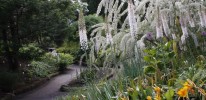- #EE04
- Botanical Garden Lai 38, Tartu, Estonia
- +3727376180
- botaed@ut.ee
- http://www.ut.ee/botaed/
- Working hours*:
Monday - Sunday
10:00 -17:00 - Prices*:
Adults (greenhouses) - 3€
Students, collegians, pensioners, UT employees (greenhouses) - 2€
Family ticket: 2 parents + kids (greenhouses) - 8€
Tour in Estonian/Russian (up to 25 people) - 25 €
Tour in Finnish/English/German (up to 25 people) - 45 € - * - opening and closing times as well as entrance prices, are subject to alterations without notice. Visitors are advised to check before visiting.
- Visiting the outdoor parts of the garden is free!
- 58.3848750, 26.7209620 Copy to clipboard Copy
-
#Parks
The University of Tartu Botanical Gardens was founded in 1803, onto the area of the current Tiigi st. park. The founder and first manager of the botanical gardens was professor G. A. Germann. He brought the gardens to it’s current place in 1806, near the corner bastion of the former city wall. The garden was designed and the construction was supervised by J.A. Weinmann. The design remains mainly the same as originally. A bronze bust and a memorial stone to prof. Germann are located on the circular wall of the old bastion, under the old limes.
In 1811 , C.F. Ledebour became the professor of science, also worked as the director of the botanical gardens for 25 years. During that time, the area of the garden has increased in the northwestern side, then the garden became as big as it is nowadays - 3,5ha.
A tropical greenhouse was built into the bastion’s valley, also many expeditions were carried out to investigate the flora of the Russian Empire. Due to those expeditions, many new plant species spreaded to western Europe. Later, the gardens were run by A.G. Bunge, N. Kuznetsov, T. Lippmaa, A. Vaga and others. Ledebour created an assistant director position, on which worked many later scientists, like E.R. Trauvetter, C.J. Maximowicz, B. Hryniewicki. The famous predecessors are reminded on boards, located on the wall of the institute.Gardenmap from 1873
Nowadays, about 10 000 species of plants can be found in the collections, which originate from tundra to tropical rainforests. The botanical garden is has the most species in Estonia and offers a great opportunity to familiarize with them.
The mission of the garden is to teach the visitors the diversity of the flora, saving usage of plantal resources and protection. The experimental and propagation gardens are in Oa street.
The Greenhouses
The Palm House, built in 1982 has the height of 22 meters and the floor area of 500 m2. There are 58 species of palm trees originating from America, Africa, Asia and Europe. The highest palm is the California fan palm (Washingtonia filifera) and the oldest palm is Canary date palm (Phoenix canariensis) – 90 years. There is gorgeous liana bougainvillea (Bougainvillea glabra) climbing along the balcony. On the hot sunny side of the balcony we can find succulent plants. In the middle of the house an epiphyte tree is exposed – a trunk with bromeliads and cacti displaying a typical rainforest habitat. Under the bananas there is a pool with fish and tortoises.
The subtropical house displays plants of subtropics from all over the world. First two beds consist of plants from Australia – the most common representative is eucalyptus, which in Australia grow into enormous trees and with acacia build up 95% of native dendroflora. The ground-covering plant here is Viola hederacea. The big fir-like tree is Araucaria cunninghami from the Mediterranean region. The representative of Africa is Harpephyllum caffrum. The tree with the syringa-like blossoms is Melia azedarach from East-Asia. American plants are represented with Juanulloa mexicana from genus Solanacea.
In the tropical house the main goal is to expose the representatives from tropical America. Some of them are grown from seeds and seedlings brought directly from expeditions. The tropical climate zone has no seasons and the changes in the amount of rainfall and temperature are minimal. We expose tropical epiphytes – bromelias and orchids, lianas and trees. Among the best-accommodated plants are begonias and Heliconia psittacorum – taken to our garden from the expedition to French Guajana in 2006. The most remarkable wooden plants are Bauhinia forficata and the representatives of Myroxylon.
The collection of succulents introduces plants that have become adapted to life in dry climate, bright sunlight and strong winds. In order to survive plants have their means of protection – a strong covering or cuticula, wax layer, hairs and spikes, deep ribs. Leaves can be thick and coriaceous, or indeed transformed into hair. The stem has become the tissue that preserves and assimilates water. The homes of such plants, with minor exceptions, are Africa and Central and South America. The collection on 100 m2 consists of 600 taxa. The African cactuses are the following – Aloe, Aeonium, Crassula, Euphorbiaceae. The representatives of the New World are Cactacea, Agavaceae. The oldest plants here are the 80-year old Golden barrel cacti (Echinocactus grusonii). The succulents from the genera Allaudia and Pachypodium, originating from Madagascar, have a peculiar exterior.






